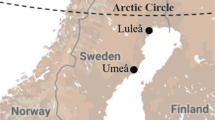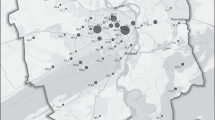Abstract
The urban snowpack effectively acts as a collection device for atmospheric-deposited PAHs. When these PAHs are flushed out in a short time interval along with springtime snowmelt, these cause shockloading to receiving waters. In order to assess the PAH deposition and accumulation in urban snowpacks, a deposition survey of PAH for the winter months of 1991–92 from the city of Sault Ste. Marie, Ontario, Canada was undertaken. The results of the survey are interpreted in view of prevailing meteorology and various emission sources in the study area. The relative PAH deposition levels (to BaP) are compared with relative source emission fingerprints to examine consistency in sampling and analysis.
While analyzing the PAH samples using the ASTM (1987) method, the problem of concentration levels being below the detection level was encountered. The ASTM method for PAH analysis was modified to enhance the detection limit of the PAHs by concentrating the PAH extract to very low volumes, on the order of 200–300 μL.
Similar content being viewed by others
References
ASTM (American Society for Testing materials (1987): Standard test method for polynuclear hydrocarbons in water. Vol.11.02, 239–245
Beard, A.;Naikwadi, K.;Karasek, F.W. (1992): Comparison of extraction methods for PCDD and PCDF in flyash using gas chromatography—mass spectrometry analysis. Journal of Chromatography589, 265–270
Bjorseth, A. Bjorseth, O;Fjeldstad, E. (1978): PAH in the work atmosphere: determination in a coke plant. Scand. J. Work Environ. and Health4, 224–236
Boom, A.;Marsalek, J. (1988): Accumulation of polycyclic aromatic hydrocarbons (PAHs) in an urban snowpack. Sci. Total Env.74, 133–148
Daisey, J. M.;Cheney, J. L.;Lioy, P.J. (1986): Profiles of organic particulate emissions from air pollution sources: status and needs for receptor source apportionment modelling. J. Air Pollution Control Association36, 17–33
Ellis, J.B.;Revitt, M.;Gavens, A. (1985): Polyaromatic hydrocarbon distributed in sediments of an urban catchment. International J. Environ. Anal. Chem.21, 161–170
Hangebrauck, R.P.;Lehmden, D.J.;Meeker, J.E. (1967): Sources of polynuclear hydrocarbons. US dept. of Health, Education and Welfare Public health Service, Bureau of Disease Prevention and Environmental Control, Cincinnati, Ohio
Kauss, P.B.;Hamdy, Y.S. (1991): Polycyclic aromatic hydrocarbons in surficial and cages mussels of the St. Marys River, 1985. Hydrobiologia219, 37–62
Lygen, E.;Gjessing, E.;Berglind, L. (1984): Pollutant transport from a highly. Sci. Total Env. 33, 147–159
Marsalek, J. (1990): Pollutant accumulation in urban snowpack. In International Conference on Urban Hydrology under Wintry Conditions, March 19–21, Narvik, Norway
Naikwadi, K.P.;Charbonneau, G.M.;Karasek, F.W. (1987): Separation and identification of organic compounds in air particulate extracts by high performance liquid chromatography and chromatography-mass spectrometry. J. of Chromatography398, 227–237
Pistikopoulos, P.;Masclet;Mouvier, G. (1990): A receptor model adapted to reactive species: polycyclic aromatic hydrocarbons; evaluation of source contribution in an open urban site-I. Particle compound. Atmospheric Environment24A, 1189–1197
Ramdahl, T.;Alfheim, I.;Bjorseth, A. (1983): PAH emission from various sources and their evolution over the last decades. In Mobile Source Emissions including Polycyclic Aromatic Hydrocarbons,Rondie, D.;Cooke, M andHaroz R.K.D. Eds., Reidel Publishing Company, Dordrecht, Holland
Schondorf, T.;Herrmann, R. (1987): Transport and chemodynamics of organic micropollutants and ions during snowmelt. Nordic Hydrology18, 259–278
Sharma, M.;McBean, E.;Thomson, N.;Marsalek, J. (1994a): Source receptor modelling of PAHs using deposition levels in winter-long urban snowpack. ASCE, Journal of Environmental Engineering 120, 1248–1265
Sharma, M.;Marsalek, J.;McBean, E. (1994b): Migration Pathways and remediation of urban runoff for PAH control. Journal of Environmental Management41, 325–336
Walters, R.W.;Luthy, R.G. (1984): Liquid/suspended phase partitioning of polycyclic aromatic hydrocarbons in coal coking wastewaters. Water Research18, 795–809
Author information
Authors and Affiliations
Corresponding author
Rights and permissions
About this article
Cite this article
Sharma, M., McBean, E.A. PAH deposition to snow surface. Environ Sci & Pollut Res 8, 11–18 (2001). https://doi.org/10.1007/BF02987290
Received:
Accepted:
Issue Date:
DOI: https://doi.org/10.1007/BF02987290




